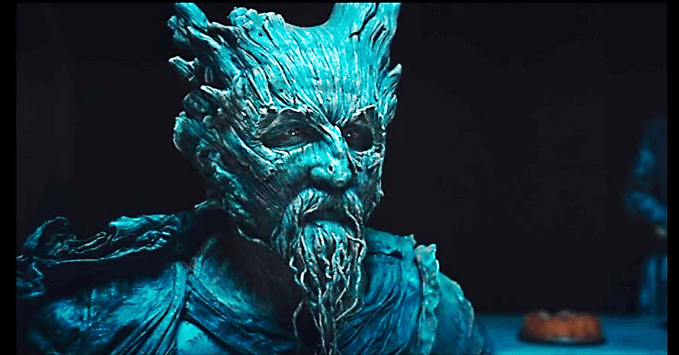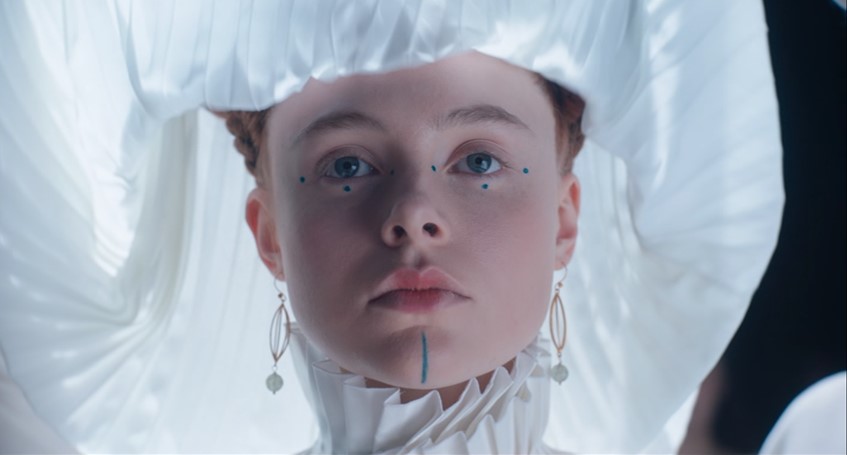directed by David Lowery
2021
129 minutes
When the Green Knight (Ralph Ineson) challenges Arthur’s knights to a bizarre and deadly Christmas game, Gawain (Dev Patel) accepts and beheads him. The Knight reclaims his severed head and promises to return the stroke in a year’s time if Gawain seeks him out.
The more distant the past, the less evidence survives for the historian. Many of the chronicle sources on which we base our understanding of what happened in the Middle Ages are barely more reliable than the fictions of Mallory or Shakespeare. Those seeking to understand how mediaeval people thought and felt have increasingly turned to the art and literature that they created. Seldom the work of a single author, these works offer a glimpse of the opinions and interests of tellers, copyists, and adaptors as well as the original creator. Most filmmakers remain more comfortable trying to create a ‘realistic’ or ‘documentary’ portrayal of past, itself an impossibility. Very few have attempted to recreate the inner worlds of those who lived there. In ‘The Green Knight’ David Lowery leads us into the dreamscape of mediaeval romance and reveals a world of signs and wonders that makes most other cinematic fantasies seem monochrome and mundane in comparison.
The tale of Gawain and the Green Knight stands slightly apart from the mainstream of Arthurian mythology. Its author is unknown, but language and style suggest that it came from northern England and was intended for aristocratic audiences. It’s no surprise that Gawain’s story has proved more resistant to cinematic adaptation than some other Arthurian romances. Both Stephen Weeks’ attempts to bring Gawain to the screen (1973 and 1981) are disappointing despite his clear fascination for the material and David Rudkin’s (1991) adaptation for Thames Television has slipped into cult obscurity. Enigmatic and dreamlike, this tale lacks the narrative thrust and action of Mallory’s “Morte d’Arthur” (1485) but also the frantic, hyperbolic fantasy of most mediaeval romances. The poem is suffused with paradox: Gawain’s quest is instigated by magic, but the tale abounds with realistic events and detail; giants, dragons and brigands are mentioned in passing but more intimate encounters, in bedroom and hall are given greater emphasis. The poem’s intent focus on character and motivation prefigures the rise of more complex fictions.
Lowery and his creative team adopt a refreshingly idiosyncratic approach to this mediaeval literary classic. Daniel Hart’s eclectic score sounds both ancient and modern, a fitting accompaniment for the film’s otherworldly visuals. Katinka Vindelev contributes two stirring Middle English carols that suit the poem’s seasonal setting. Distinctive calligraphic chapter heading titles by Teddy Blanks are carefully integrated with the action and recall the poems heritage in print and manuscript forms. Malgosia Turzanska’s ingenious costume designs eschew fur, and leather for an eclectic range of non-animal fabrics; these organic textures suggest scale, leaf or bark embellished with a startling colour palette and intricate detailing. Whilst the poem’s Green Knight is a handsome, aristocratic figure, here he appears carved from the wild wood; gnarled and bosky. To jaded modern eyes, he presents a more singular, uncanny presence than an actor in green hose and make-up. The poem contains vivid and lyrical descriptions of landscape; Andrew Droz Palermo’s photography and some unobtrusive digital artistry paint the Irish locations anew to create a colourful and sometimes hallucinogenic setting for this ancient tale.
Although the screenplay occasionally stumbles over mediaeval grammar, and one character utters a jarringly anachronistic ‘okay’ at a particularly intimate moment the dialogue never lapses into parody. The language maintains an elegant, musical timbre which recalls the audacious alliterative wordplay of the original. Like the poem, the film celebrates the steady rhythm of the seasons which governed life for so many people in pre-industrial society and reminds us of how quickly a year can pass as he compresses months into minutes whilst the camera tracks around a woodland glade. In the original poem, the Green Knight issues his challenge to Arthur’s court in its prime and Gawain is already a knight of great renown. Here Arthur (a spectral, intense Sean Harris) recalls the fading Fisher King of the grail quests and Guinevere (Kate Dickie) is ailing. Gawain is not yet a knight and is uncertain of his role in this sombre and moribund court. Modern readers may struggle to relate to the source text’s emphasis on Christian piety and virtuous celibacy. Instead, Lowery’s retelling focusses on our hero’s rite of passage; Dev Patel’s winning performance emphasises Gawain’s disarming sweetness and essential goodness rather than his chivalric virtues. To his credit, Lowery acknowledges the centrality of Christianity in mediaeval culture with references to the legend of Saint Winifred and some subtle details like the image of the Virgin Mary on the back of Gawain’s shield. As in the original tale, this Green Knight has lessons to teach us.
Many (though not all) cinematic representations of this period remain preoccupied with armour and weapons. In fairness, most of the mediaeval romances that inspired these films are also primarily interested in feats of battle. These stories allowed readers and listeners to indulge fantasies of physical prowess and romantic love unconstrained by the social and moral constraints of everyday life. In Lowery’s ‘The Green Knight’ Gawain does very little fighting. He constantly reminds those he encounters that he is not yet a knight and quickly loses both his armour and horse. He must choose whether to become knight and king or remain Gawain and renounce ambition. Truth was considered the central defining quality for mediaeval men, whereas guile was considered a female quality. Direct language and straight dealing cemented social relationships regardless of social rank. In the original poem Gawain’s quest fails not because of his cowardice but because he cheats at the game. In the film Gawain proves his manhood by choosing honesty in his dealings with the Green Knight, despite the risk to his life. In the moment of revelation before the axe falls, he sees that cheating death may grant him glory but at a terrible cost. Viewers expecting a neat resolution for Gawain may be disappointed, but we are in the hands of a generous storyteller who leaves it up to us to decide Gawain’s fate. Although Lowery changes the original tale’s resolution he retains his source’s distinctive tone of moral ambiguity. In the poem Gawain wins, but he also loses, here he loses but also wins. The Green Knight’s final, enigmatic smile suggests that Gawain has chosen well.
In mediaeval literature woman is often cast in the role of temptress, romantic love negates man’s emotional independence and robs him of his precious bodily fluids. The female characters in the Gawain poem serve to remind him of the temptations of the flesh. Lowery challenges the more misogynistic elements of mediaeval culture by subtly reconfiguring the role of women in his film. Gawain’s lover, the prostitute Essel (Alicia Vikander) offers him the opportunity of a simpler life, but the bell that she gives him as a love token remains a poignant reminder that their relationship must end if he achieves his dreams of chivalric glory. Gawain may be tempted by the Lady (also played, tellingly, by Vikander), but she also questions the nature of ambition, focussing instead on the transience of earthly glory, the rot beneath the surface glitter. Her perceptive camera obscura portrait of Gawain captures his innocence and helps him to recognise the gulf between his fantasies of knighthood and the harsh realities of power. Those who argue that this ‘The Green Knight’ strays too far from the original tale misunderstand the nature and value of stories. Tales, like those who tell and read them, must adapt to survive. If the original Gawain can help us to understand the desires and fears of our ancestors, then this twenty first century Gawain can also tell us something about ourselves. Celibacy and piety may be too much to ask but, in a world obsessed by celebrity and spin, humility and honesty remain virtues to which both men and women can aspire. ‘The Green Knight’ is clearly a labour of love for cast and crew. It has an exquisite, hand-crafted feel, like a hand-illuminated manuscript. Steeped in metaphor, the film remains true to mediaeval culture’s penchant for playful symbolism. You may not understand all the arcane references here, but the greatest art leaves some secrets unexplained. Rest assured; you will revisit ‘The Green Knight’ to marvel at its beauty and ponder its mysteries.
Quotes:
“Why greatness? Why is goodness not enough?” Essel (Alicia Vikander)
“May the Blessed Virgin keep your five fingers strong, your five senses sharp. May her five joys inspire you. The five wounds of her son give you fervour. And the five virtues of a knight light your way. Keep thy covenant, young Gawain.” Queen (Kate Dickie)
Connections
Film and Television
‘Gawain and the Green Knight’ Directed by Stephen Weeks (1973)
‘Sword of the Valiant’ Directed by Stephen Weeks (1981)
‘The Navigator’ Directed by Vincent Ward (1988)
‘Gawain and the Green Knight’ Directed by David Rudkin, Thames (1991)
‘The Anchoress’ Directed by Chris Newby (1993)
‘A Ghost Story’ Directed by David Lowery (2017)
Reading
Geraldine Heng, Empire of Magic: Mediaeval Romance and the Politics of Cultural Fantasy, Columbia, 2003, ISBN 0231125274
Gawain and the Green Knight (translated by Bernard O’Donoghue), Penguin, 2006, ISBN 9780140424539
D. G. Neal, The Masculine Self in Late Mediaeval England, University of Chicago Press, 2008, ISBN 9780226569574
Radio
BBC Radio 4: ‘In Our Time’ 21st May 2020 – Sir Gawain and the Green Knight



You must be logged in to post a comment.